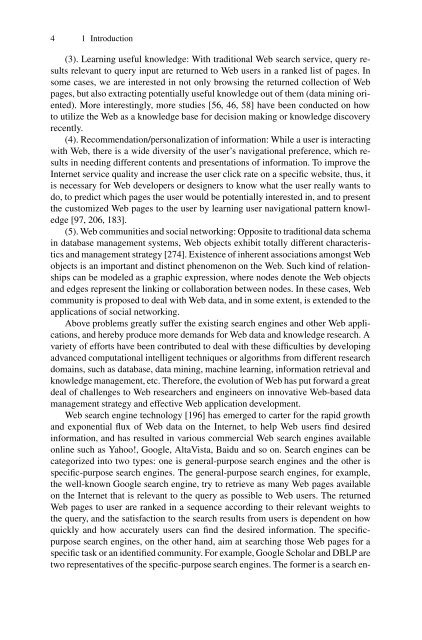Web Mining and Social Networking: Techniques and ... - tud.ttu.ee
Web Mining and Social Networking: Techniques and ... - tud.ttu.ee
Web Mining and Social Networking: Techniques and ... - tud.ttu.ee
- No tags were found...
Create successful ePaper yourself
Turn your PDF publications into a flip-book with our unique Google optimized e-Paper software.
4 1 Introduction(3). Learning useful knowledge: With traditional <strong>Web</strong> search service, query resultsrelevant to query input are returned to <strong>Web</strong> users in a ranked list of pages. Insome cases, we are interested in not only browsing the returned collection of <strong>Web</strong>pages, but also extracting potentially useful knowledge out of them (data mining oriented).More interestingly, more s<strong>tud</strong>ies [56, 46, 58] have b<strong>ee</strong>n conducted on howto utilize the <strong>Web</strong> as a knowledge base for decision making or knowledge discoveryrecently.(4). Recommendation/personalization of information: While a user is interactingwith <strong>Web</strong>, there is a wide diversity of the user’s navigational preference, which resultsin n<strong>ee</strong>ding different contents <strong>and</strong> presentations of information. To improve theInternet service quality <strong>and</strong> increase the user click rate on a specific website, thus, itis necessary for <strong>Web</strong> developers or designers to know what the user really wants todo, to predict which pages the user would be potentially interested in, <strong>and</strong> to presentthe customized <strong>Web</strong> pages to the user by learning user navigational pattern knowledge[97, 206, 183].(5). <strong>Web</strong> communities <strong>and</strong> social networking: Opposite to traditional data schemain database management systems, <strong>Web</strong> objects exhibit totally different characteristics<strong>and</strong> management strategy [274]. Existence of inherent associations amongst <strong>Web</strong>objects is an important <strong>and</strong> distinct phenomenon on the <strong>Web</strong>. Such kind of relationshipscan be modeled as a graphic expression, where nodes denote the <strong>Web</strong> objects<strong>and</strong> edges represent the linking or collaboration betw<strong>ee</strong>n nodes. In these cases, <strong>Web</strong>community is proposed to deal with <strong>Web</strong> data, <strong>and</strong> in some extent, is extended to theapplications of social networking.Above problems greatly suffer the existing search engines <strong>and</strong> other <strong>Web</strong> applications,<strong>and</strong> hereby produce more dem<strong>and</strong>s for <strong>Web</strong> data <strong>and</strong> knowledge research. Avariety of efforts have b<strong>ee</strong>n contributed to deal with these difficulties by developingadvanced computational intelligent techniques or algorithms from different researchdomains, such as database, data mining, machine learning, information retrieval <strong>and</strong>knowledge management, etc. Therefore, the evolution of <strong>Web</strong> has put forward a greatdeal of challenges to <strong>Web</strong> researchers <strong>and</strong> engin<strong>ee</strong>rs on innovative <strong>Web</strong>-based datamanagement strategy <strong>and</strong> effective <strong>Web</strong> application development.<strong>Web</strong> search engine technology [196] has emerged to carter for the rapid growth<strong>and</strong> exponential flux of <strong>Web</strong> data on the Internet, to help <strong>Web</strong> users find desiredinformation, <strong>and</strong> has resulted in various commercial <strong>Web</strong> search engines availableonline such as Yahoo!, Google, AltaVista, Baidu <strong>and</strong> so on. Search engines can becategorized into two types: one is general-purpose search engines <strong>and</strong> the other isspecific-purpose search engines. The general-purpose search engines, for example,the well-known Google search engine, try to retrieve as many <strong>Web</strong> pages availableon the Internet that is relevant to the query as possible to <strong>Web</strong> users. The returned<strong>Web</strong> pages to user are ranked in a sequence according to their relevant weights tothe query, <strong>and</strong> the satisfaction to the search results from users is dependent on howquickly <strong>and</strong> how accurately users can find the desired information. The specificpurposesearch engines, on the other h<strong>and</strong>, aim at searching those <strong>Web</strong> pages for aspecific task or an identified community. For example, Google Scholar <strong>and</strong> DBLP aretwo representatives of the specific-purpose search engines. The former is a search en-




![[ ] rad - tud.ttu.ee](https://img.yumpu.com/51069910/1/184x260/-rad-tudttuee.jpg?quality=85)












